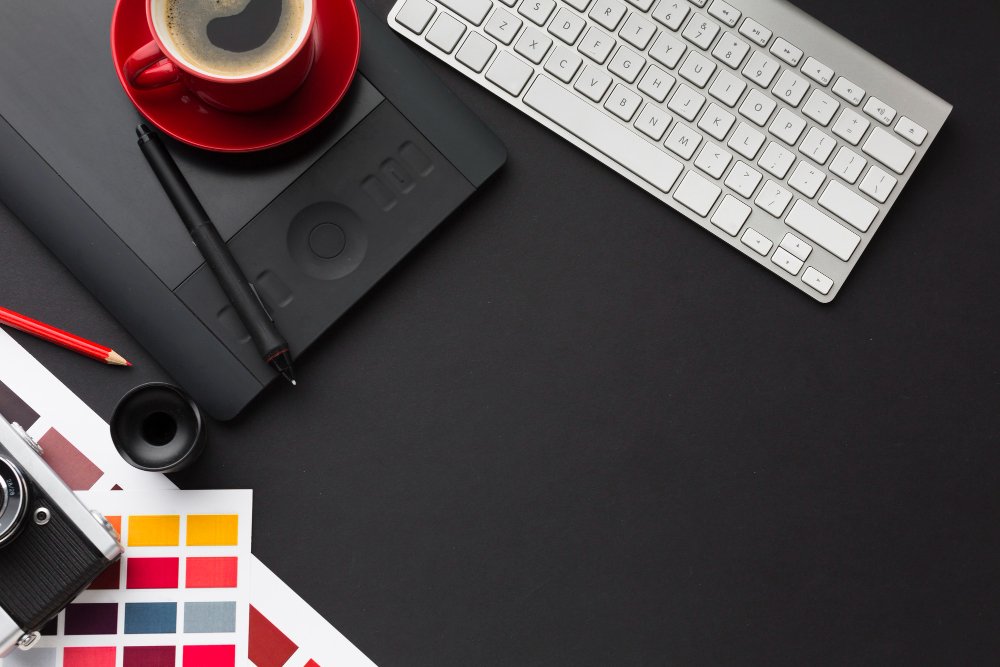In the dynamic world of graphic design, software tools have become indispensable. From creating stunning visual elements to enhancing user experience, these tools play a crucial role in bringing artistic visions to life. One key importance of software tools in graphic design is their ability to streamline and automate tasks, saving designers precious time and allowing them to focus on the creative process. With features like templates and presets, designers can easily create consistent designs while maintaining their unique style.
Furthermore, software tools enable designers to push boundaries and explore new possibilities that were previously unimaginable. With advanced editing capabilities, intricate details can be perfected with precision, resulting in visually stunning creations. These tools also provide access to an extensive library of digital assets such as fonts, images, and icons, expanding the range of design elements available to designers and allowing for more diverse and captivating compositions.
Software tools also play a crucial role in collaboration within the graphic design industry. Design teams can work together seamlessly by utilizing shared files or cloud-based platforms which facilitate real-time feedback and edits. This not only improves efficiency but also promotes creativity through idea exchange between team members. In addition, these tools often support project management functionalities like task assignments and progress tracking, which ensures smooth coordination among team members.
Overall, it is clear that software tools are vital for graphic designers in achieving their goals efficiently and effectively. Their ability to automate tasks, open up new creative opportunities, and facilitate collaboration among teams makes them invaluable assets in this ever-evolving field of design. As technology continues to advance at a rapid
Adobe Creative Suite:
Adobe Creative Suite is undoubtedly one of the most popular software tools used in graphic design. With a wide range of programs like Photoshop, Illustrator, and InDesign, it caters to various needs of designers and artists. What sets Adobe apart is its user-friendly interface combined with powerful features that allow for endless creativity.
Photoshop, for instance, revolutionized the way we edit photos. From simple touch-ups to complex manipulation, this program enables designers to transform images into stunning works of art. Illustrator, on the other hand, offers extensive vector editing capabilities, which make it perfect for creating logos and illustrations with sharp lines and smooth curves. And who can forget InDesign? This program is the go-to choice for designing layouts for print media such as magazines and brochures.
One key advantage of using Adobe Creative Suite is its compatibility across programs. Users can seamlessly transfer elements between different software without losing quality or formatting issues. This convenience not only saves time but also allows for a more efficient workflow – an essential aspect in fast-paced industries like graphic design.
Moreover, Adobe regularly updates their suite with new features and enhancements based on user feedback and industry trends. This keeps designers ahead of the game and ensures they have access to cutting-edge tools that enable them to push boundaries creatively.
In conclusion, Adobe Creative Suite has earned its reputation as one of the most popular software tools in graphic design due to its versatility across programs like Photoshop, Illustrator, and InDesign. The compatibility between these programs not only saves time but also allows
Overview of the popular Adobe software tools used in graphic design
Adobe is a household name when it comes to graphic design, and their software tools have become industry standards. One of the most popular Adobe software tools used in graphic design is Adobe Photoshop. Photoshop allows designers to manipulate and enhance images with its extensive array of editing features. From simple retouching to complex photo compositions, Photoshop offers endless possibilities for creating stunning visuals.
Another widely used Adobe software tool in graphic design is Adobe Illustrator. This vector-based program focuses on creating scalable graphics and illustrations. With its vast selection of drawing tools, designers can create intricate logos and artwork that can be resized without losing any quality. What sets Illustrator apart is its ability to create clean lines and shapes that are perfect for print or web use.
Lastly, Adobe InDesign holds an important place in the world of graphic design as the go-to layout program for publishing purposes. Designers can create professional-looking documents such as brochures, magazines, and books using InDesign’s precise alignment guides and typography features. Its versatility makes it an invaluable tool for both print and digital projects.
In conclusion, there are several popular Adobe software tools used in graphic design that offer unique capabilities for different aspects of the creative process. Whether it’s editing photos in Photoshop, creating illustrations in Illustrator, or designing layouts in InDesign, these tools provide essential functionalities that ensure high-quality results for any graphic designer’s projects.
CorelDRAW:
One of the most popular software tools used in graphic design is CorelDRAW. Known for its versatility and powerful capabilities, CorelDRAW has been a favorite among designers for decades. It offers a range of features that allow users to create stunning visual designs, from logo creation to typography and illustration.
What sets CorelDRAW apart is its intuitive user interface, making it accessible to both beginners and experienced designers. Its vast library of templates and design assets also helps expedite the creative process, providing users with a multitude of starting points for their projects. Additionally, CorelDRAW’s compatibility with other industry-standard software, such as Photoshop and Illustrator, allows for seamless integration into existing workflows.
Designers who choose CorelDRAW appreciate its wide range of customization options, giving them complete control over their creations. From precise color management to advanced editing tools, there are endless possibilities to explore within this software. Moreover, CorelDRAW’s emphasis on collaboration makes it an excellent choice for team-based projects, as it enables multiple users to work simultaneously on the same project.
In conclusion, if you’re looking for powerful graphic design software that offers versatility, ease-of-use, customization options, and collaboration features – look no further than CorelDRAW. Whether you’re a beginner or an expert designer in need of professional-grade tools, this software is sure to meet all your creative needs. With its long-standing popularity within the industry and continuous updates from the developers at Corel Corporation, there’s no doubt that CorelDRAW will continue to
Explanation of CorelDRAW and its features for graphic design
CorelDRAW is one of the most powerful software tools used in graphic design that offers a wide range of features to create stunning visual designs. Its intuitive interface and versatile functionality make it a go-to choice for designers across various industries. One key feature of CorelDRAW is its vector editing capability, allowing designers to create scalable artwork with ease. This means that images can be resized without losing quality, making it ideal for logos, icons, and illustrations.
Another standout feature of CorelDRAW is its extensive color management system. Designers have full control over color palettes, with the ability to create custom swatches and manage color consistency across different projects and media types. This allows for precise branding and ensures that colors remain accurate when printed or displayed digitally.
Furthermore, CorelDRAW includes powerful typography tools that give designers creative freedom when working with text. The software offers an array of font options and allows for easy manipulation and customization, such as kerning, tracking, and other typographic adjustments. Additionally, CorelDRAW’s Paragraph Text tool makes it convenient to handle large amounts of text while maintaining formatting consistency.
In conclusion, CorelDRAW continues to be a leading choice among graphic designers due to its robust set of features. From vector editing to advanced color management and typography tools – this software provides the necessary elements needed to bring design visions into reality efficiently. Whether you are creating print materials or digital graphics, this versatile program has you covered every step of the way.
Canva:
One of the most popular graphic design tools used today is Canva. With its simple and intuitive interface, Canva has made creating stunning designs accessible to even those with no prior design experience. It offers a wide range of pre-designed templates for everything from social media posts to marketing materials, making it quick and easy to create professional-looking graphics.
What sets Canva apart from other design tools is its drag-and-drop functionality, which allows users to easily add elements such as text, images, and shapes to their designs. Additionally, Canva offers a vast library of free and premium stock photos, illustrations, and icons that can be easily incorporated into any project. This makes it a valuable resource for designers looking for inspiration or needing high-quality visuals.
Furthermore, one of the key strengths of Canva is its collaborative features. Multiple team members can work on the same project simultaneously, making it perfect for group projects or agency collaborations. The ability to share designs with clients or colleagues for feedback in real time streamlines the design process and ensures everyone is on the same page.
Overall, Canva’s user-friendly interface, plentiful templates and assets, as well as its collaborative nature make it an indispensable tool in the world of graphic design. Whether you are a professional designer or someone needing graphics for personal use, Canva empowers users to effortlessly bring their creative visions to life without compromising on quality or style
Discussion on Canva and its user-friendly interface for beginners
Canva is undoubtedly one of the most popular software tools used in graphic design, primarily because of its user-friendly interface that caters to beginners. The platform provides a wide range of pre-designed templates, making it easy for anyone to create visually appealing graphics even without prior design experience. What sets Canva apart is its simplicity – with just a few clicks, users can access numerous design elements such as fonts, images, and shapes to customize their creations.
The intuitive drag-and-drop feature allows beginners to experiment with different layouts and designs effortlessly. This user-friendly interface encourages creativity and empowers novice designers by eliminating the steep learning curve usually associated with graphic design tools. Additionally, Canva offers an extensive library of tutorials and resources that provide step-by-step guidance on how to use various features effectively. With Canva’s beginner-friendly interface and comprehensive support system, individuals new to graphic design can confidently dive into the world of creative expression.
Overall, Canva’s emphasis on user-friendliness has democratized graphic design by removing barriers typically faced by beginners. Its intuitive interface not only enables them to create professional-looking visuals but also boosts confidence in their own artistic abilities. As more people continue to explore the field of graphic design through platforms like Canva, we can expect a surge of fresh perspectives and innovative designs from previously untapped talents who now have the means to showcase their create.
Sketch:
One of the most popular software tools in graphic design is Sketch. It has gained a strong following and become an industry standard for many professional designers. With its user-friendly interface and robust features, Sketch allows designers to create high-quality vector graphics, layouts, and prototypes.
What sets Sketch apart from other graphic design tools is its focus on vector graphics. Unlike pixel-based software like Photoshop or Illustrator, which can limit scalability and cause loss of quality when resizing designs, Sketch offers infinite scalability with its vector-based approach. This makes it ideal for creating logos, icons, and other assets that need to be resized across different platforms without losing their crispness.
Another key feature that sets Sketch apart is the ability to easily share and collaborate on designs. With plugins like Craft by InVision, designers can seamlessly sync their files with prototyping tools or handoff specifications to developers directly within the app. This streamlines workflow processes and enhances collaboration between team members.
Whether you are a beginner or an experienced designer looking to add new skills to your repertoire, learning how to use Sketch will undoubtedly enhance your graphic design toolkit. Its intuitive interface, powerful vector capabilities, and collaborative features make it a must-have tool for any designer striving for excellence in their work.
Overview of Sketch and its advantages for web and UI/UX designers
Sketch is a powerful design tool that has gained immense popularity among web and UI UX designers in recent years. This vector-based software offers a wide range of features and functionalities specifically designed to meet the needs of these professionals. One key advantage of Sketch is its simplicity and user-friendly interface, making it easy for designers to quickly learn and master.
Another major advantage of Sketch is its extensive library of plugins and integrations. With the help of these plugins, designers can easily extend the functionality of Sketch according to their specific requirements. This allows them to save time by automating repetitive tasks, improving productivity, and ultimately delivering better designs.
Moreover, Sketch offers robust collaboration features that make it an ideal choice for teams working on web and UI UX projects. Designers can easily share their work with team members or clients, get real-time feedback, make revisions on the go, and ensure seamless collaboration throughout the design process.
Overall, Sketch provides web and UI UX designers with a comprehensive set of tools that streamline their workflow and empower them to create stunning designs efficiently. Its simplicity, extensive library of plugins, and collaborative features make it an invaluable asset for professionals in this field.
Conclusion:
In conclusion, graphic designers have a wealth of software tools at their disposal to bring their visions to life. From Adobe Photoshop for image editing and manipulation to Canva for simple and easy designing, each tool has its own unique features and benefits. Additionally, it is essential for designers to stay updated with the latest trends in software tools as new technologies emerge.
However, no matter how advanced or popular a software tool may be, it is ultimately the skills and creativity of the designer that make all the difference. Software tools are just mediums through which ideas are executed; they cannot replace originality and talent. Therefore, while it’s important to familiarize yourself with popular software tools in graphic design, remember that your passion and uniqueness will always set you apart.
In conclusion, graphic design is an ever-evolving field that relies heavily on technology-driven solutions. The popularity of certain software tools may fluctuate over time, but staying adaptable and open-minded will help designers thrive in this dynamic industry. By continuously learning about new tools emerging in the market while honing their core design skills, graphic designers can stay relevant and create impactful visual content that stands out from the crowd. Ultimately, though, it’s not solely about the tools used but rather how they are wielded by expert designers who have a deep understanding of both artistry and technological functionality.
Recap of the most popular software tools in graphic design
When it comes to graphic design, there are several software tools that have become must-haves for every designer. One of these is Adobe Photoshop, which has been the go-to software for editing and creating images for years. Its wide range of features and tools make it an indispensable tool for graphic designers.
Another popular software tool in graphic design is Adobe Illustrator. This vector-based program allows designers to create scalable illustrations and artwork that can be used in a variety of contexts. The program’s simplicity and versatility make it a favorite among both beginners and experienced professionals alike.
In recent years, Sketch has gained popularity among designers as a powerful vector graphics editor exclusively available on macOS. With its intuitive user interface and focused feature set, Sketch offers a more streamlined approach to designing interfaces and web graphics. The program’s ability to collaborate with other designers makes it an essential choice for any team working on digital designs.
In conclusion, while there are many different software tools available in the field of graphic design, Adobe Photoshop, Adobe Illustrator, and Sketch remain some of the most popular choices among professionals in the industry. These tools continue to evolve and improve with each new update, ensuring that they will remain relevant and widely used.







